Themed collection Global Energy Challenges: Solar Energy

Surface engineering to achieve organic ternary memory with a high device yield and improved performance
Organic memories fabricated on surface-engineered indium tin oxide show the highest ternary yield (82%) to date and better performance.
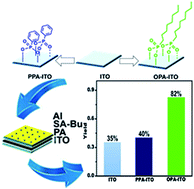
Chem. Sci., 2017,8, 2344-2351
https://doi.org/10.1039/C6SC03986C
Molecular engineering and sequential cosensitization for preventing the “trade-off” effect with photovoltaic enhancement
Cosensitization of two dyes with different molecular sizes and photovoltaic characteristics is demonstrated to successfully prevent the “trade-off” effect, leading to an excellent power-conversion efficiency of 10.09% under one-sun and 11.12% under 0.3 sun 4 irradiation.
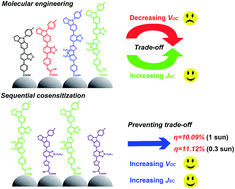
Chem. Sci., 2017,8, 2115-2124
https://doi.org/10.1039/C6SC03938C
Donor–acceptor–acceptor (D–A–A) type 1,8-naphthalimides as non-fullerene small molecule acceptors for bulk heterojunction solar cells
Donor–acceptor–acceptor (D–A–A) type 1,8-naphthalimide based small molecules SM1 and SM2 functionalized with tetracyanobutadiene (TCBD) and dicyanoquino-dimethane (DCNQ) modules, showing strong absorption in the visible and near-infrared (NIR) region are reported.

Chem. Sci., 2017,8, 2017-2024
https://doi.org/10.1039/C6SC04461A
On thermodynamic inconsistencies in several photosynthetic and solar cell models and how to fix them
We analyze standard theoretical models of solar energy conversion developed to study solar cells and photosynthetic systems.
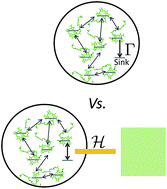
Chem. Sci., 2017,8, 1008-1014
https://doi.org/10.1039/C6SC04350J
Gradient doping of phosphorus in Fe2O3 nanoarray photoanodes for enhanced charge separation
Highly-oriented Fe2O3 nanoarrays with a gradient phosphorus concentration result in enhanced charge separation in the bulk for photoelectrochemical water oxidation.
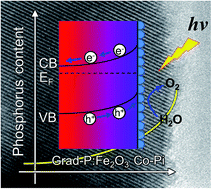
Chem. Sci., 2017,8, 91-100
https://doi.org/10.1039/C6SC03707K
Stable α/δ phase junction of formamidinium lead iodide perovskites for enhanced near-infrared emission
A stable α/δ phase junction of formamidinium lead iodide perovskites was realized via controllable precursors at a low annealing temperature for enhanced near-infrared emission.
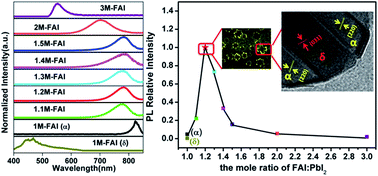
Chem. Sci., 2017,8, 800-805
https://doi.org/10.1039/C6SC03542F
Indolo[3,2-b]indole-based crystalline hole-transporting material for highly efficient perovskite solar cells
A fluorinated indolo[3,2-b]indole (IDID) derivative is prepared as a crystalline hole transporting material for perovskite solar cells. A fluorinated IDID backbone enables a tight molecular stacking by π–π interaction. The device fabricated using IDIDF exhibits a PCE of 19%.
![Graphical abstract: Indolo[3,2-b]indole-based crystalline hole-transporting material for highly efficient perovskite solar cells](/en/Image/Get?imageInfo.ImageType=GA&imageInfo.ImageIdentifier.ManuscriptID=C6SC02832B&imageInfo.ImageIdentifier.Year=2017)
Chem. Sci., 2017,8, 734-741
https://doi.org/10.1039/C6SC02832B
Photodriven hydrogen evolution by molecular catalysts using Al2O3-protected perylene-3,4-dicarboximide on NiO electrodes
Photodriven charge transfer dynamics are described for an atomic layer deposition-stabilized, organic dye-sensitized photocathode architecture that produces hydrogen.
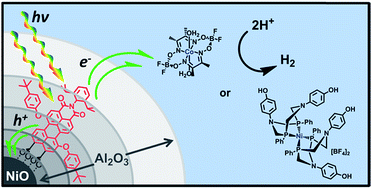
Chem. Sci., 2017,8, 541-549
https://doi.org/10.1039/C6SC02477G
Regioisomer effects of [70]fullerene mono-adduct acceptors in bulk heterojunction polymer solar cells
Regioisomer separations of [70]fullerene mono-adducts for polymer solar cell (PSC) applications were conducted for the first time.
![Graphical abstract: Regioisomer effects of [70]fullerene mono-adduct acceptors in bulk heterojunction polymer solar cells](/en/Image/Get?imageInfo.ImageType=GA&imageInfo.ImageIdentifier.ManuscriptID=C6SC02950G&imageInfo.ImageIdentifier.Year=2017)
Chem. Sci., 2017,8, 181-188
https://doi.org/10.1039/C6SC02950G
Achievement of visible-light-driven Z-scheme overall water splitting using barium-modified Ta3N5 as a H2-evolving photocatalyst
Barium-modified Ta3N5 for the promotion of proton reduction is first employed as a H2-evolving photocatalyst for visible-light-driven Z-scheme overall water splitting.

Chem. Sci., 2017,8, 437-443
https://doi.org/10.1039/C6SC02750D
Metalloporphyrin-modified semiconductors for solar fuel production
A novel synthetic method is used to prepare metalloporphyrin-modified gallium phosphide photocathodes for solar-driven hydrogen evolution from water.
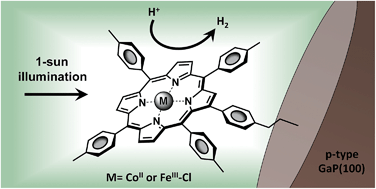
Chem. Sci., 2017,8, 253-259
https://doi.org/10.1039/C6SC02664H
Photothermal-enhanced catalysis in core–shell plasmonic hierarchical Cu7S4 microsphere@zeolitic imidazole framework-8
A strategy to improve reaction activity via the photothermal effect of plasmonic semiconductor nanomaterials is demonstrated in a core–shell structured catalyst.
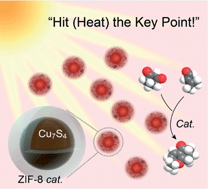
Chem. Sci., 2016,7, 6887-6893
https://doi.org/10.1039/C6SC03239G
Enhancement of charge transport properties of small molecule semiconductors by controlling fluorine substitution and effects on photovoltaic properties of organic solar cells and perovskite solar cells
Effects of fluorine substitution of small molecular semiconductor on charge transport and photovoltaic properties are systematically studied.
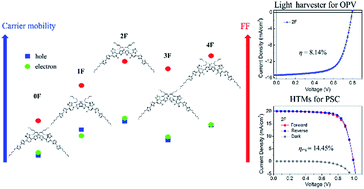
Chem. Sci., 2016,7, 6649-6661
https://doi.org/10.1039/C6SC02448C
Tantalum nitride films integrated with transparent conductive oxide substrates via atomic layer deposition for photoelectrochemical water splitting
The first example of tantalum nitride electrodes on transparent conductive oxide substrates, which enables solar water splitting, is presented.
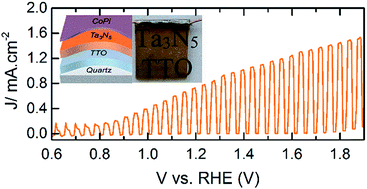
Chem. Sci., 2016,7, 6760-6767
https://doi.org/10.1039/C6SC02116F
Synthetically tuneable biomimetic artificial photosynthetic reaction centres that closely resemble the natural system in purple bacteria
Synthetically flexible, rigid, tetrad molecules are shown to closely mimic structural and photochemical properties of the bacterial photosynthetic reaction centre.
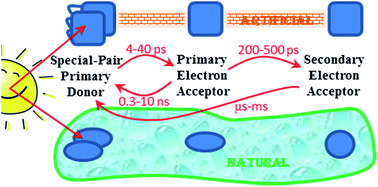
Chem. Sci., 2016,7, 6534-6550
https://doi.org/10.1039/C6SC01076H
A polymer acceptor with an optimal LUMO energy level for all-polymer solar cells
A new polymer acceptor based on the BNBP unit with an optimal LUMO energy level has been developed. The resulting all-polymer solar cells show high PCEs, remarkably high Voc values and small photon energy losses.
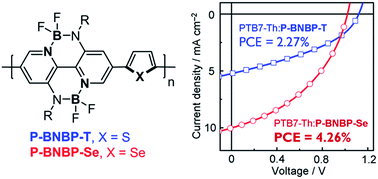
Chem. Sci., 2016,7, 6197-6202
https://doi.org/10.1039/C6SC01756H
Dithieno[3,2-b:2′,3′-d]pyridin-5(4H)-one based D–A type copolymers with wide bandgaps of up to 2.05 eV to achieve solar cell efficiencies of up to 7.33%
A PCE of 7.33% was achieved in a PSC based on a new copolymer, PDTPO-IDT, with bandgaps of up to 2.05 eV.
![Graphical abstract: Dithieno[3,2-b:2′,3′-d]pyridin-5(4H)-one based D–A type copolymers with wide bandgaps of up to 2.05 eV to achieve solar cell efficiencies of up to 7.33%](/en/Image/Get?imageInfo.ImageType=GA&imageInfo.ImageIdentifier.ManuscriptID=C6SC01791F&imageInfo.ImageIdentifier.Year=2016)
Chem. Sci., 2016,7, 6167-6175
https://doi.org/10.1039/C6SC01791F
Understanding the anatase–rutile phase junction in charge separation and transfer in a TiO2 electrode for photoelectrochemical water splitting
The key to phase junctions for efficient charge separation is to consider both the phase alignment and interface structure.
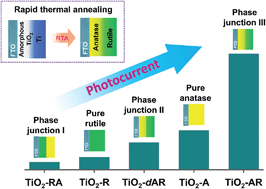
Chem. Sci., 2016,7, 6076-6082
https://doi.org/10.1039/C6SC01611A
Donor–π–donor type hole transporting materials: marked π-bridge effects on optoelectronic properties, solid-state structure, and perovskite solar cell efficiency
Donor–π-bridge–donor type oligomers (D–π–D) have been studied intensively as active materials for organic optoelectronic devices.

Chem. Sci., 2016,7, 6068-6075
https://doi.org/10.1039/C6SC01478J
A “roller-wheel” Pt-containing small molecule that outperforms its polymer analogs in organic solar cells
“Roller-wheel” shaped Pt-containing molecules display enhanced crystallinity and are better performing organic solar cell materials than conventional small molecules and polymers featuring “dumbbell” shaped structures.
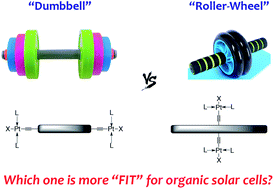
Chem. Sci., 2016,7, 5798-5804
https://doi.org/10.1039/C6SC00513F
Effect of multi-armed triphenylamine-based hole transporting materials for high performance perovskite solar cells
The performance of planar perovskite solar cells was enhanced by using hole transporting materials containing triphenylamine groups with a multi-armed structure.
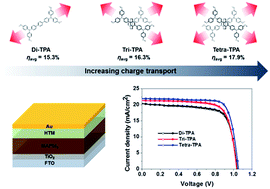
Chem. Sci., 2016,7, 5517-5522
https://doi.org/10.1039/C6SC00876C
Photoelectrochemical hydrogen production in water using a layer-by-layer assembly of a Ru dye and Ni catalyst on NiO
Layer-by-layer assembly of a Ru dye and Ni catalyst on a p-type NiO photocathode enables photoelectrochemical H2 generation in water.

Chem. Sci., 2016,7, 5537-5546
https://doi.org/10.1039/C6SC00715E
Effects of heteroatom substitution in spiro-bifluorene hole transport materials
By introducing the heteroatom into the benchmark hole transport material Spiro-MeOTAD, the energy level of hole transport materials can be tuned.
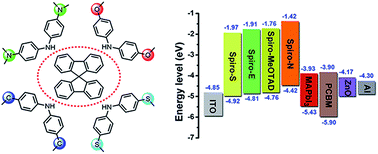
Chem. Sci., 2016,7, 5007-5012
https://doi.org/10.1039/C6SC00973E
Unveiling iodine-based electrolytes chemistry in aqueous dye-sensitized solar cells
The chemistry behind the I−/I3− redox couple is thoroughly investigated in 100% aqueous dye-sensitized solar cells, paving the way to this emerging green PV technology.
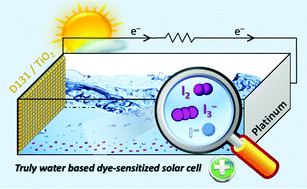
Chem. Sci., 2016,7, 4880-4890
https://doi.org/10.1039/C6SC01145D
On the application of the tolerance factor to inorganic and hybrid halide perovskites: a revised system
Can new hybrid perovskites be predicted using the tolerance factor?
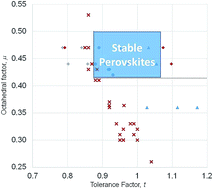
Chem. Sci., 2016,7, 4548-4556
https://doi.org/10.1039/C5SC04845A
Insight into the charge transfer in particulate Ta3N5 photoanode with high photoelectrochemical performance
Charge transfer has been demonstrated to have a fundamental role in particulate Ta3N5 electrode for achieving high efficient photoelectrochemical water oxidation.
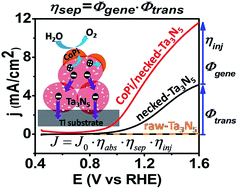
Chem. Sci., 2016,7, 4391-4399
https://doi.org/10.1039/C6SC00245E
Structural engineering of porphyrin-based small molecules as donors for efficient organic solar cells
Three A–D–A porphyrin-based small molecules are employed as donors in bulky heterojunction organic solar cells. Striking a delicate balance between solubility, morphology and device fabrication, leads to PCEs of up to 7.7%.
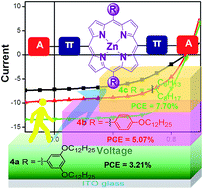
Chem. Sci., 2016,7, 4301-4307
https://doi.org/10.1039/C5SC04783H
Ligand enhanced upconversion of near-infrared photons with nanocrystal light absorbers
Tetracene derivatives enhance near-infrared photon upconversion by maximizing energy transfer from PbS and PbSe nanocrystal light absorbers.
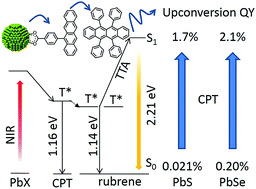
Chem. Sci., 2016,7, 4101-4104
https://doi.org/10.1039/C6SC00257A
Precious-metal free photoelectrochemical water splitting with immobilised molecular Ni and Fe redox catalysts
Splitting water into hydrogen and oxygen with 3d transition metal molecular catalysts and light has been accomplished.
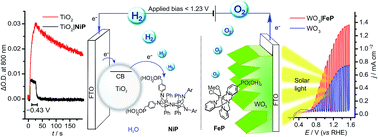
Chem. Sci., 2016,7, 4024-4035
https://doi.org/10.1039/C5SC04863J
Tunable and highly efficient light-harvesting antenna systems based on 1,7-perylene-3,4,9,10-tetracarboxylic acid derivatives
Efficient harvesting of solar energy, without interference from electron transfer, is reported for a series of bichromophoric light-harvesting antenna molecules.
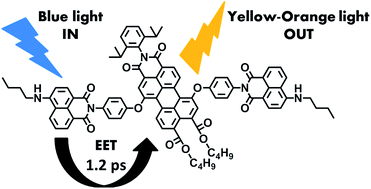
Chem. Sci., 2016,7, 3517-3532
https://doi.org/10.1039/C6SC00386A
Enhancement of dye regeneration kinetics in dichromophoric porphyrin–carbazole triphenylamine dyes influenced by more exposed radical cation orbitals
Dye regeneration kinetics is enhanced by five times in a di-chromophoric porphyrin dye by attaching tridimensionally enlarged electron donor moieties.
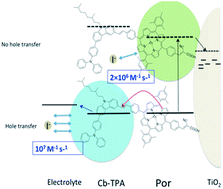
Chem. Sci., 2016,7, 3506-3516
https://doi.org/10.1039/C6SC00429F
Ring-fusion as a perylenediimide dimer design concept for high-performance non-fullerene organic photovoltaic acceptors
A series of perylenediimide (PDI) dimers are evaluated as acceptors for organic photovoltaic (OPV) cells.
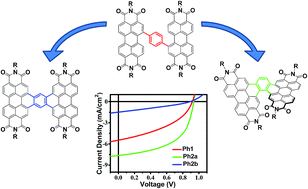
Chem. Sci., 2016,7, 3543-3555
https://doi.org/10.1039/C5SC04956C
Understanding the origin of photoelectrode performance enhancement by probing surface kinetics
Probing the surface kinetics of different hematite electrodes with and without surface passivations.
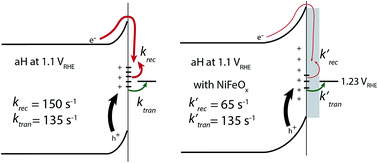
Chem. Sci., 2016,7, 3347-3354
https://doi.org/10.1039/C5SC04519C
High conductivity Ag-based metal organic complexes as dopant-free hole-transport materials for perovskite solar cells with high fill factors
Two Ag-based metal organic complexes (HA1 and HA2) are employed as a new class of dopant-free HTMs for the application in PSCs. The cell based on HA1 achieved high PCE of 11.98% under air conditions, which is comparable to the PCE of the cell employing the doped spiro-MeOTAD (12.27%) under the same conditions.
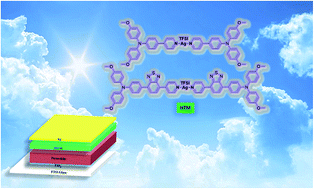
Chem. Sci., 2016,7, 2633-2638
https://doi.org/10.1039/C5SC03569D
Tethered tertiary amines as solid-state n-type dopants for solution-processable organic semiconductors
Tertiary amines covalently tethered to electron-deficient aromatic molecules by alkyl spacers enable solid-state n-doping.
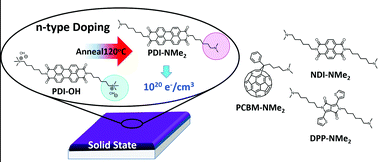
Chem. Sci., 2016,7, 1914-1919
https://doi.org/10.1039/C5SC04217H
Understanding and removing surface states limiting charge transport in TiO2 nanowire arrays for enhanced optoelectronic device performance
An effective wet-chemistry approach is demonstrated to minimize the trap states that limit electron transport in rutile TiO2 nanowire arrays, this leads to an over 20-fold enhancement in the electron diffusion coefficient.

Chem. Sci., 2016,7, 1910-1913
https://doi.org/10.1039/C5SC04076K
Visible light-driven water oxidation using a covalently-linked molecular catalyst–sensitizer dyad assembled on a TiO2 electrode
The combination of porphyrin as a sensitizer and a ruthenium complex as a water oxidation catalyst (WOC) is promising to exploit highly efficient molecular artificial photosynthetic systems.

Chem. Sci., 2016,7, 1430-1439
https://doi.org/10.1039/C5SC03669K
Spatial separation of oxidation and reduction co-catalysts for efficient charge separation: Pt@TiO2@MnOx hollow spheres for photocatalytic reactions
The design and synthesis of fine Pt@TiO2@MnOx hollow spheres is described. Pt and MnOx are spatially separated by TiO2 shells. The catalyst exhibits high efficiency of charge-separation and surface-reaction.
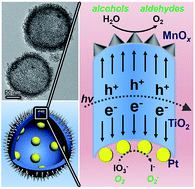
Chem. Sci., 2016,7, 890-895
https://doi.org/10.1039/C5SC04163E
Quasi-type II CuInS2/CdS core/shell quantum dots
Both single and multiple exciton lifetimes are significantly extended in quasi-type II CuInS2/CdS core/shell QDs.
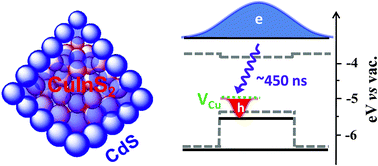
Chem. Sci., 2016,7, 1238-1244
https://doi.org/10.1039/C5SC03715H
Ruthenium(II)-polypyridyl zirconium(IV) metal–organic frameworks as a new class of sensitized solar cells
Ruthenium(II) polypyridyl-doped metal–organic framework sensitized films on TiO2 for photovoltaics reveal that the preparative method of dye doping/incorporation into the MOF is integral to the total solar cell efficiency.
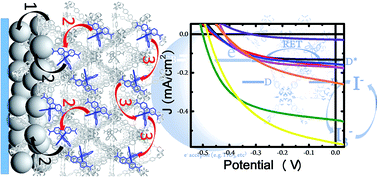
Chem. Sci., 2016,7, 719-727
https://doi.org/10.1039/C5SC01565K
Increased upconversion performance for thin film solar cells: a trimolecular composition
A dual-emitter upconvertor is applied to thin-film solar cells for the first time, generating record figures of merit.
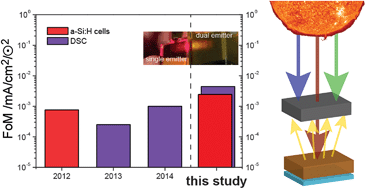
Chem. Sci., 2016,7, 559-568
https://doi.org/10.1039/C5SC03215F
Unprecedentedly targeted customization of molecular energy levels with auxiliary-groups in organic solar cell sensitizers
Lowering the LUMOs and decreasing energy “waste” is targeted through inserting an auxiliary group from an electron donor or acceptor into D–π–A organic sensitizers, and the photovoltaic efficiency increases 38 fold from 0.24 to 9.46%.
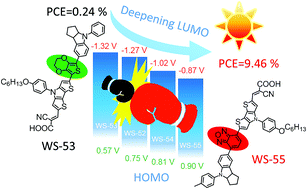
Chem. Sci., 2016,7, 544-549
https://doi.org/10.1039/C5SC02778K
Solar-microbial hybrid device based on oxygen-deficient niobium pentoxide anodes for sustainable hydrogen production
A new solar-microbial hybrid device based on oxygen-deficient Nb2O5 anodes for sustainable hydrogen generation without external bias was demonstrated.
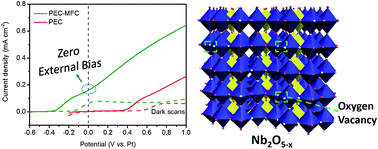
Chem. Sci., 2015,6, 6799-6805
https://doi.org/10.1039/C5SC03249K
Water splitting with polyoxometalate-treated photoanodes: enhancing performance through sensitizer design
Improved sensitizer design dramatically enhances visible light-driven water oxidation from dye-sensitized TiO2 photoanodes treated with polyoxometalate water oxidation catalyst [{Ru4O4(OH)2(H2O)4}(γ-SiW10O36)2]10−.

Chem. Sci., 2015,6, 5531-5543
https://doi.org/10.1039/C5SC01439E
Vibrational properties and bonding nature of Sb2Se3 and their implications for chalcogenide materials
There is more to chemical bonding in chalcogenides than the shortest, strongest bonds, as revealed by microscopic quantum-chemical descriptors.
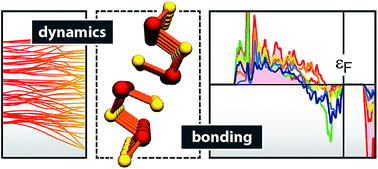
Chem. Sci., 2015,6, 5255-5262
https://doi.org/10.1039/C5SC00825E
Wide bandgap OPV polymers based on pyridinonedithiophene unit with efficiency >5%
We report the properties of a new series of wide band gap photovoltaic polymers based on the N-alkyl 2-pyridone dithiophene (PDT) unit.

Chem. Sci., 2015,6, 4860-4866
https://doi.org/10.1039/C5SC01427A
Oxygen deficient α-Fe2O3 photoelectrodes: a balance between enhanced electrical properties and trap-mediated losses
Intrinsic doping of hematite through the inclusion of oxygen vacancies (VO) is being increasingly explored as a simple, low temperature route to preparing active water splitting α-Fe2O3−x photoelectrodes.
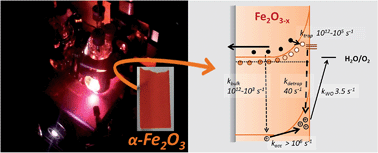
Chem. Sci., 2015,6, 4009-4016
https://doi.org/10.1039/C5SC00423C
Methyl viologen-templated zinc gallophosphate zeolitic material with dual photo-/thermochromism and tuneable photovoltaic activity
The first zeolitic material templated by MV2+ cations exhibits dual photo-/thermochromism with ultralong-lived charge separation and high thermal stability, as well as tuneable photovoltaic activity.
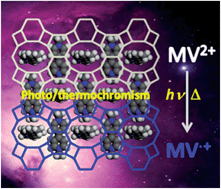
Chem. Sci., 2015,6, 2922-2927
https://doi.org/10.1039/C5SC00291E
Design of two-photon molecular tandem architectures for solar cells by ab initio theory
We present new two-photon molecular architectures for photovoltaics where atomic precision can be obtained by synthetic chemistry.
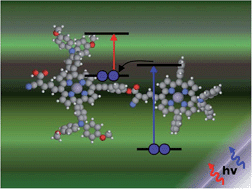
Chem. Sci., 2015,6, 3018-3025
https://doi.org/10.1039/C4SC03835E
Ultrafast exciton quenching by energy and electron transfer in colloidal CdSe nanosheet–Pt heterostructures
Large in-plane exciton mobility in CdSe nanosheets leads to ultrafast exciton quenching by energy transfer to Pt.

Chem. Sci., 2015,6, 1049-1054
https://doi.org/10.1039/C4SC02994A
Reversible photo-induced trap formation in mixed-halide hybrid perovskites for photovoltaics
A reversible photo-induced instability has been found in mixed-halide photovoltaic perovskites that limits the open circuit voltage in solar cells.
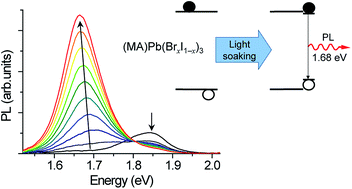
Chem. Sci., 2015,6, 613-617
https://doi.org/10.1039/C4SC03141E
Long-lived charge carrier generation in ordered films of a covalent perylenediimide–diketopyrrolopyrrole–perylenediimide molecule
Self-ordering of covalent electron donor–acceptor building blocks in thin films upon solvent vapor annealing results in a 104 increase in photo-generated charge carrier lifetime.

Chem. Sci., 2015,6, 402-411
https://doi.org/10.1039/C4SC02551B
About this collection
We are delighted to present an online collection showcasing recently published articles in the field of energy. To address major issues facing our planet, researchers all over the world have increasingly focused their efforts on finding solutions to these energy challenges. These articles highlight some of the excellent work that tackles important global challenges related to energy. We hope you enjoy reading this collection!